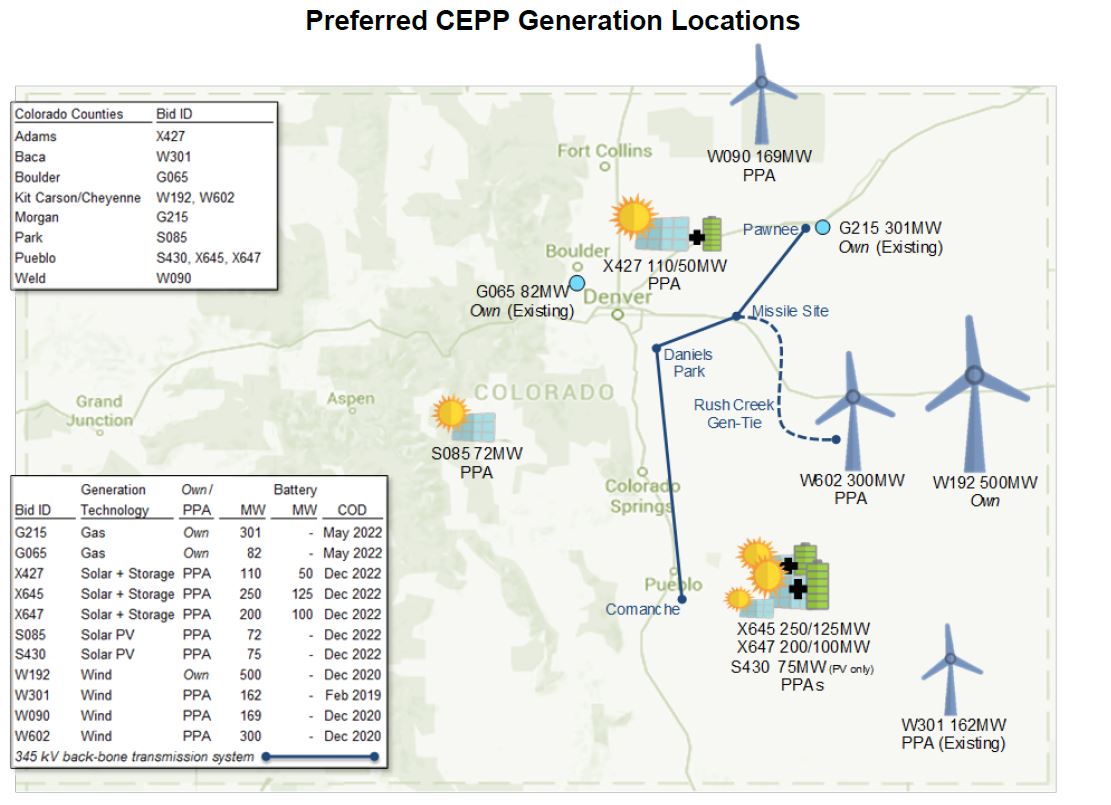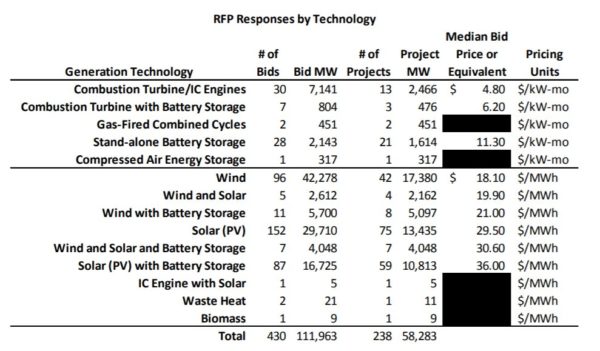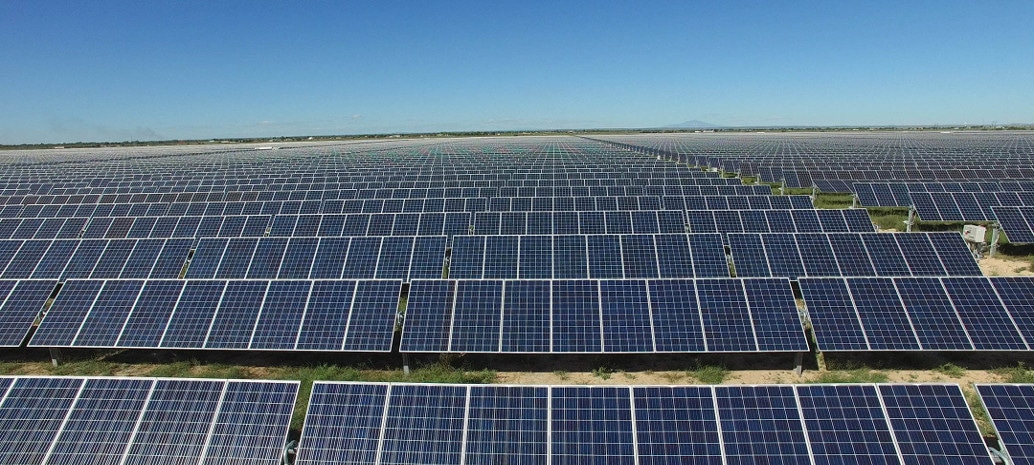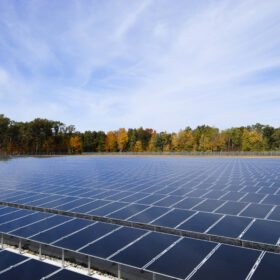Yesterday, August 27, 2018 around 3:31 PM MST, the Colorado Public Utilities Commission (CPUC) voted 2-1 to provide initial approval of Xcel Energy’s Preferred Colorado Energy Plan Portfolio (CEPP). This plan is among several that were considered as part of the 2016 Electric Resource Plan. Formal written approval of the plan is expected by September 4.
https://www.twitter.com/erinoverturf/status/1034191622089596928
While there are a lot of big (and little) numbers floating in last night’s vote, what is really a huge deal is that coal is directly retiring, and gas is explicitly not being built, whereas solar+wind+energy storage are. The energy transition is happening in Colorado in a big way.
The plan calls for retiring Xcel’s coal-fired Comanche Generating Station ten years early, which represents 660 MW of total capacity for two separate units at the site. The Comanche plant represent approximately one-third of Xcel Energy’s remaining coal fleet. The plan does not call for any new gas plants to be built, as earlier versions of the plan had proposed.
This will mean that by 2026, Colorado will reduce CO2 emissions by 60% below their 2005 levels, and will be powered more than 55% by renewable electricity.

The plan features a total of five solar power plants, three of which include include energy storage. Three of these plants – 525 MW-AC worth of solar and 225 MW/ 900 MWh of energy storage – are located in the Pueblo region. A single 72 MW-AC solar plant is located in Park, the western part of the state. And a 110 MW-AC solar plant plus 50MW / 100 MWh of energy storage is located in Adams.
The total solar to be deployed under this plan would be 707 MW-AC, with 275 WM/1,000 MWh of energy storage. The solar power bids ranged from 2.3-2.7¢/kWh, while solar plus storage ranged from 3.0-3.2¢/kWh. While it makes for an imperfect comparison as solar project costs vary, the solar vs solar+storage delta is 0.5-0.8¢/kWh.

This plans approval comes shortly after a deal between Xcel Energy and steelmaker EVRAZ that includes the building of a 240 MW solar project near the company’s Rocky Mountain Steel mill in Pueblo, Colorado, by far the largest behind the meter project ever seen by pv magazine.
Besides all the numbers being numbingly large in capacity and low in price, is the broader continued pattern of solar, wind and energy storage clearly being built in replacement of fossil fuels. In the case of Colorado, we’re actually seeing that customers will save hundreds of millions of dollars even when we’re closing coal plants a decade early – plants that are simply no longer a good economic investment.
The questions that utilities across the United States, and world, are now asking is not if a transition to renewable energy will happen, but how they are going to make the leap themselves. With the coal and nuclear energy begging for handouts to sustain their dying business models, it is clear where the future lies.
This content is protected by copyright and may not be reused. If you want to cooperate with us and would like to reuse some of our content, please contact: editors@pv-magazine.com.








As a Colorado resident I am happy the electricity and air will be cleaner!
The sooner the better and I certainly wish it was sooner than 2026.
Is there any government subsidies in addition to these prices?
I presume the land is a gift and all connection costs are gifts from the State
Are most homes and businesses gas heated?
Is there any external emergency support such as a connector link to another city or state or a national grid?
It looks too good to be true
Cheers
Graham
Assuming the solar projects start construction before the decline of the 30% federal Investment Tax Credit (ITC), they will get that. I don’t know if any wind will start before the Production Tax Credit goes away, but wind is cheap enough that it probably doesn’t matter.
I haven’t heard that any land or connection costs here are gifts, and would be highly surprised if they were.
Adding more wind and solar has been shown to correlate with more reliable grids, not less, in large part due to the generally more distributed nature of solar and wind deployment versus large centralized power stations. However, Colorado is also linked electrically to New Mexico, Utah and Wyoming as part of the Western Interconnection.
Thankyou
Which contractors have been selected for this solar work?
I’m sure your company knows procurement managers.
“1,131 megawatts of wind, 707 megawatts of solar PV, and 275 megawatts of battery storage across the state”
Let’s assume capacity factors for Colorado – 44% for wind, 23% for solar and try to estimate a single capacity factor for the total 1,131 + 707 = 1,838 MW. 1,131 x 0.44 + 707 x 0.23 = 660 = 0.36 x 1,838
So I estimate a capacity factor of 36% for the total wind + solar mix.
My “Wind, storage and back-up system designer” web-page generates this “Grid Watch Demand Focus Table” for a peak demand of 660 MW.
http://scottish.scienceontheweb.net/Wind%20power%20storage%20back-up%20calculator.htm?peak=660&cf=36#grid
So these rows suggest suitable configurations that could replace the 660 MW of coal generation.
As you can see, with only 1,838 MW of wind + solar power, there is enough generation for a row C system configuration.
However, there is not enough energy storage. The story doesn’t specify what capacity of energy storage there is but knowing the snake oil salesman who sell these not fit-for-purpose far-too-small battery systems it won’t supply 275 MW for more than a few hours at most. They probably won’t have even 1000 MWh when what is needed is up to 12 times that or 12,672 MWh energy storage for a row C configuration.
We know that 275 MW is not enough regeneration power from storage because ideally you’d want 660 MW regeneration power to meet peak demand (of 660 MW) at night from storage if and when there is a lull in wind generation.
From table 3 we can add up a total of 383 MW of back-up power from gas generation will be available. That’s plenty for ANY of the configuration rows in my table, which is good.
So renewable generation is sufficient, back-up power is sufficient but once again we see a system design when the inadequate energy storage is simply not up to the job to replace the 660 MW coal power station.
It’s a half-baked job and we must demand better than this from Xcel or anyone who offers to replace coal generation with renewable generation.
They should add a suitably sized pumped storage scheme to complete the system. It should have 660 MW of turbines and pumps and 12,700 MWh of energy storage, if they wanted to minimise back-up power gas usage, though the system would still work with much less energy storage capacity, as little as 3,800 MWh but using more gas back-up power and energy.
Sad to see Co is joining NJ, NY, Mass, Ct, and Ca.
The real underlying engineering-centric economics are only visible if you strip out subsidies, hyperbole, regulatory subterfuge, and fake prices that emerge from mandates. Fortunately, both the Department of Energy and SEC filings of public corporations provide plenty of reliable data about the core engineering costs of the hardware needed to produce energy, whether solar panels, wind turbines, or drilling rigs. Here’s what they show:
Buy $1 million worth of solar panels and, over a 30-year operating period, they will produce about 25 million kilowatt-hours (kWh).
By comparison, $1 million worth of a modern wind turbine will produce 50 million kWh over the same 30 years.
Alternatively, purchase $1 million worth of a shale rig and, over those same 30 years, that capital will produce enough natural gas to generate 400 million kWh. The 400 is not a typo. That same $1 million of hardware producing natural gas yields 10 and 20-fold more ‘product’ (kWh) than either wind or solar respectively. And this basic fact explains why, over the past decade, private investment in shale gas has added 500% more energy to America than government subsidized wind and solar combined.
Sad day indeed.